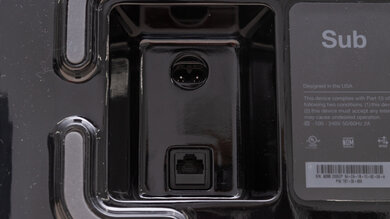The Samsung HW-Q59CT is a 5.1 setup released in 2021. It uses built-in Acoustic Beam technology to more accurately localize sound objects for a more immersive listening experience when using its 'Surround Sound' and 'Game Mode Pro' presets. The manufacturer also says that you can use its Q-Symphony feature with certain Samsung TVs to create a more immersive sound. If you want to listen to music, its 'Standard' preset has a pretty neutral sound profile that's suitable for most types of audio content, but unfortunately, it doesn't support Dolby Atmos content.
Note: The manufacturer advertises this soundbar as a 5.1 setup. However, during our tests, we found that it has a 3.1 setup when using its 'Standard' preset. With its 'Game Mode Pro' and 'Surround Sound' presets, it uses Acoustic Beam technology to simulate a 5.1 setup, which the manufacturer says helps with sound positioning to create a more immersive listening experience.
Our Verdict
The Samsung HW-Q59CT is decent for mixed usage. With its 'Standard' preset, it has a neutral sound profile with a little extra punch in the bass range that's still suitable for most types of audio content. It's well-suited for dialogue-heavy content, thanks to its discrete center channel. You can also use its 'Surround Sound' or 'Game Mode Pro' presets to activate its Acoustic Beam technology for a more immersive surround sound, though these presets aren't ideal for listening to music. Unfortunately, it doesn't support Atmos content.
- Graphic EQ and presets.
- Bass and treble adjustments.
- No Atmos support.
- Lacks low-bass.
The Samsung HW-Q59CT soundbar is very good for dialogue-centric content like TV shows. Its balanced mid-range can reproduce voices clearly and with detail, and its discrete center channel helps accurately localize dialogue within the sound image. There's even a dialogue enhancement feature to make voices more crisp and clear. While you can wirelessly stream podcasts from your phone to the bar via Bluetooth, unfortunately, it doesn't support Wi-Fi, Apple AirPlay, or Chromecast built-in.
- Dialogue enhancement mode.
- Auto-volume mode.
- No Wi-Fi, Apple AirPlay, or Chromecast built-in support.
The Samsung HW-Q59CT is good for music. With its 'Standard' preset, it has a pretty neutral sound profile with a little extra punch in the bass range. It's suitable for listening to most types of audio content, and you can use the bass and treble adjustments and the graphic EQ to create a different sound if you prefer. Unfortunately, it struggles to reproduce a thumpy low-bass, so it isn't ideal for bass-heavy genres like EDM.
- Graphic EQ and presets.
- Bass and treble adjustments.
- Lacks low-bass.
The Samsung HW-Q59CT is fair for movies. Its balanced mid-range can reproduce voices clearly and with detail, though it struggles to reproduce the deep thump and rumble in action-packed scenes. With its 'Surround Sound' preset, it uses up-firing Acoustic Beam drivers to create a more immersive listening experience. Unfortunately, it doesn't support Dolby Atmos content.
- Graphic EQ and presets.
- Bass and treble adjustments.
- No Atmos support.
- Lacks low-bass.
Changelog
- Updated Jul 25, 2023: Added market comparison with the Samsung HW-Q60C in the Height (Atmos) box.
- Updated Feb 21, 2023: Added market comparison with the Samsung HW-Q600B to the Height (Atmos) box.
- Updated Oct 07, 2021: Review published.
- Updated Oct 01, 2021: Early access published.
Check Price
Differences Between Sizes And Variants
The Samsung HW-Q59CT is available in 'Black', and you can see the label for the model we tested here.
If you come across another version of this bar, please let us know in the discussions, and we'll update our review.
Popular Soundbar Comparisons
The Samsung Q59CT soundbar has a similar design to the Samsung HW-Q60T. Both soundbars are advertised as a 5.1 setup, and they use Acoustic Beam technology to create a more immersive sound with certain EQ presets. Unlike the HW-Q60T, this soundbar also supports Tap Sound, which is advertised to mirror sound from your phone to the bar when tapped against the bar.
See also our recommendations for the best soundbars under $500, the best 5.1 soundbars, and the best Samsung soundbars.
The Vizio M Series M51a-H6 is better than the Samsung HW-Q59CT. The Vizio comes with discrete satellite speakers, and unlike the Samsung soundbar, it supports Dolby Atmos content. It also offers a better surround performance and can reproduce a more extended low bass. That said, the Samsung is better built, and some listeners may prefer its graphic EQ for sound customization over the Vizio's bass and treble adjustments.
The Samsung HW-Q59CT and the Sonos Beam offer similar overall performances. The Samsung is a 5.1 setup with a dedicated sub reproducing a more extended low-bass. Unlike the Sonos, it has a Full HDMI In port for high-quality passthrough. That said, the 3.0 Sonos is better built, and its more compact design may be ideal for some users. It also has better soundstage and center performances.
The Vizio V Series V51-H6 is better than the Samsung HW-Q59CT. The Vizio has discrete satellites and offers a better surround performance. It can also reproduce a more extended low-bass and can get louder with less compression at max volume. However, the Samsung is better built with a Full HDMI In port for high-quality passthrough.
The standalone Sonos Arc is better than the Samsung HW-Q59CT. The Sonos is better built and supports Dolby Atmos content. It has better soundstage, surround, and center performances. Unlike the Samsung soundbar, it has room correction and built-in voice assistant support. However, only the Samsung has a graphic EQ and presets for sound customization.
Test Results



























